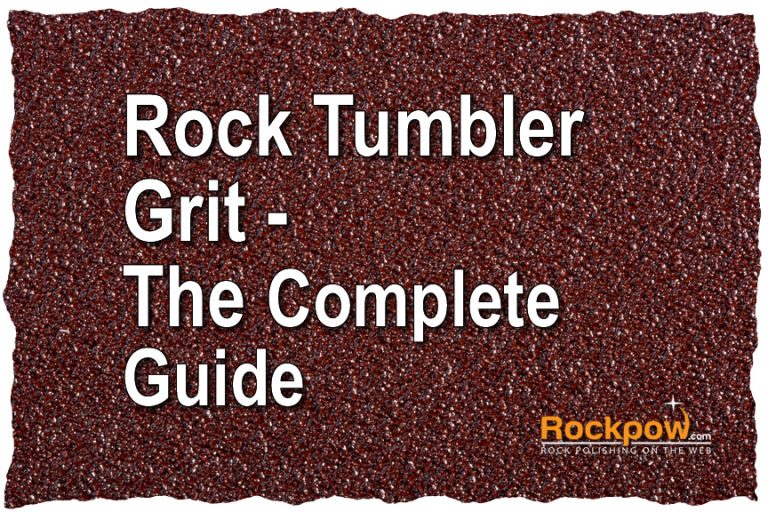You can’t polish a rock without getting rough with it first! Modern day rock tumbling involves the use of abrasive powders, known as rock tumbler grit, that range from very rough to very fine. We’ll go over exactly what these abrasives are, how they’re made, and the best ways to use them. Knowing your rock tumbling grits inside and out is very helpful for knowing exactly when to use each one. In the end, you will have better polished rocks by becoming intimately familiar with every aspect of the tools of the trade.
Rock tumbling these days, uses one main type of abrasive inside the tumbler for each of the rock polishing phases. That particular abrasive, or grit, is silicon carbide. While silicon carbide is used for all phases of grinding, you do not use the same level of abrasive in each phase. You start off with a very course grit, which consists of silicon dioxide particles that are larger making the mixture much more course, and you progressively use a finer and finer grit to achieve the polish that is seen on the final stone.
What The Heck Is Silicon Carbide?
Silicon carbide is created in a very hot oven by combining different elements and melting them into a new mixture. It comes out of this oven in chunks and is broken down into the particles that will be used to make our rock tumbling abrasives. As a side note, this same silicon carbide is also attached to paper to make…you guessed it – sand paper. The grit itself have a Mohs hardness of over 9 so it can be used to polish many hard surfaces, like the stones we work with of course!
The levels of grit are denoted by numbers. For example, a rough grit for the first stage of rock tumbling might be an 80. An intermediate grit might be 120. But what exactly do these numbers mean?
The Levels Of Rock Tumbler Grit – Breaking Down The Numbers
When looking at abrasives, you will see numbers that are usually 80, 100, 120, 220, 320, 400, 600 and 1000. Now there are other grades but these are more common than most. The numbers determines the coarseness of the grit and how aggressively they will attack the stones. The lower numbers are more aggressive and will remove more material. The higher numbers are less abrasive and move more towards polishing a stone that has been ground aggressively by a lower abrasive.
What Exactly Do Rock Polishing Grit Numbers Mean?
What do these numbers mean exactly? The numbers themselves refer to the size of the silicon carbide particles. The lower numbers are larger particles, and the higher numbers are smaller or finer particles. Obviously, a larger particle will attack more surface area and be more aggressive when polishing stones.
Another feature of silicon carbide is that the particles are very sharp when they are new. As stated before, the rock tumbling abrasives start life out as huge chunks that are broken apart into the various sizes of particles. When this happens, the particles are very sharp. These sharp edges are very good at cutting stones. Over time though, the rock tumbling action dulls the surfaces of the particles and the abrasive becomes less aggressive. So the rock polishing action will slow down over the days as it works on the rocks unless you add new abrasives to the slurry. This is usually not necessary since by the time the abrasive wears out, the stones are ready for a different level of abrasive anyway.
This is the reason, however, that rock tumbling slurry cannot be reused effectively. If the silicon carbide didn’t wear down in this manner, you could theoretically dry out the slurry and reuse the resulting abrasives. But just like sandpaper that has worn down, the abrasives in rock tumbling cannot be reused effectively.
How Can A Smaller Number Rock Tumbler Grit Be More Aggressive?
Why is 80 more course than say 120? After all, 120 is bigger than 80… shouldn’t 80 grit abrasives be smaller and less aggressive? To understand the numbering system you have to understand how the abrasive powder is made. As stated previously, it starts life out as chunks. These chunks are then broken down into particulates, and these particles are put through mesh screens. The mesh screens have a certain number of holes per inch. So, 80 grit is an abrasive that fits through a screen with 80 holes while 120 grit has to be able to fit through screens with 120 holes. The holes are smaller, so the resulting grit size is smaller. That is why the higher numbers are the ones with finer particles.
Buying and Keeping Rock Tumbling Abrasives
It can be cheaper to buy abrasive in large quantities, but there are a few things to keep in mind. If you buy a huge tub of grit, make sure you store it somewhere that it won’t get wet. This includes moisture from the air. You must keep your grit in air tight sealed containers. If they absorb too much moisture, they can clump together and be useless.
Cross Contamination Of Rock Tumbling Grit
Another thing to keep in mind is you never want to cross contaminate grit. If you were to get 80 grit into a tub of 220 grit, the 220 grit would be ruined. Since the 80 grit would not be able to be removed, the 220 grit would be unusable for a fine grinding stage. The 80 grit in the mixture would cause huge gouges in your stones and ruin any work you had done.
If on the other hand a little 220 grit gets into your 80 grit tub, it might be ok to continue to use that grit. A little 220 grit that gets mixed into a rough grinding phase is not going to do anything since it is not going to be large enough to scratch the unground rough anyway.

